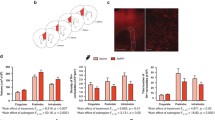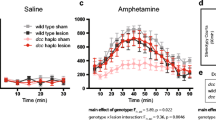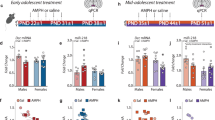Abstract
Rationale
Netrin-1 guidance cues contribute to amphetamine-induced plasticity of the adult mesocorticolimbic dopamine system in rodents. The netrin-1 receptor, deleted in colorectal cancer (DCC), is upregulated by repeated amphetamine treatment selectively in the ventral tegmental area (VTA) of adult rats and wild-type mice. Furthermore, adult dcc heterozygous mice fail to show amphetamine-induced increases in VTA DCC expression and do not develop sensitization to this drug.
Objectives
The effects of netrin-1 receptor signaling on mesocorticolimbic dopamine system function change across development. However, the effects of AMPH on DCC receptor regulation and behavioral sensitization before puberty have not been determined. Here we examined whether (1) repeated amphetamine treatment would also alter DCC expression in juvenile rats and wild-type mice, and (2) dcc heterozygotes treated with amphetamine during the juvenile period (PND 22–32) would develop behavioral sensitization to this drug.
Results
Repeated amphetamine downregulates DCC expression selectively in the VTA of juvenile rodents. Moreover, the behavioral phenotype of adult dcc heterozygous mice is not present before puberty and is abolished by amphetamine treatment during the juvenile period. Remarkably, adult dcc heterozygotes pretreated with amphetamine as juveniles no longer exhibit reduced DCC expression in the VTA compared to wild-type controls.
Conclusions
Our results indicate that netrin-1 receptor signaling may be a key factor in determining individual differences in vulnerability to the behaviorally sensitizing effects of amphetamine at different ages. Moreover, they suggest that the juvenile period marks a window of vulnerability during which exposure to stimulant drugs can reverse the behavioral phenotype of adult dcc heterozygous mice.





Similar content being viewed by others
References
Benes FM, Vincent SL, Molloy R, Khan Y (1996) Increased interaction of dopamine-immunoreactive varicosities with GABA neurons of rat medial prefrontal cortex occurs during the postweanling period. Synapse 23:237–245
Boileau I, Dagher A, Leyton M, Gunn RN, Baker GB, Diksic M, Benkelfat C (2006) Modeling sensitization to stimulants in humans: an [11C]raclopride/positron emission tomography study in healthy men. Arch Gen Psychiatry 63:1386–1395
Boudreau AC, Wolf ME (2005) Behavioral sensitization to cocaine is associated with increased AMPH receptor surface expression in the nucleus accumbens. J Neurosci 25:9144–9151
Bowers MS, Chen BT, Bonci A (2010) AMPA receptor synaptic plasticity induced by psychostimulants: the past, present, and therapeutic future. Neuron 67:11–24
Cabib S, Puglisi-Allegra S, Ventura R (2002) The contribution of comparative studies in inbred strains of mice to the understanding of the hyperactive phenotype. Behav Brain Res 130:103–109
Carr DB, Sesack SR (2000) Projections from the rat prefrontal cortex to the ventral tegmental area: target specificity in the synaptic associations with mesoaccumbens and mesocortical neurons. J Neurosci 15:3864–3873
Carr DB, O’Donnell P, Card JP, Sesack SR (1999) Dopamine terminals in the rat prefrontal cortex synapse on pyramidal cells that project to the nucleus accumbens. J Neurosci 19:11049–11060
Collo G, Zanetti S, Missale C, Spano P (2008) Dopamine D3 receptor-preferring agonists increase dendrite arborization of mesencephalic dopaminergic neurons via extracellular signal-regulated kinase phosphorylation. Eur J Neurosci 28:1231–1240
Colon-Ramos DA, Margeta MA, Shen K (2007) Glia promote local synaptogenesis through UNC-6 (netrin) signaling in C. elegans. Science 318:103–106
de Wit H (1998) Individual differences in acute effects of drugs in humans: their relevance to risk for abuse. NIDA Res Monogr 169:176–187
Feder A, Nestler EJ, Charney DS (2009) Psychobiology and molecular genetics of resilience. Nat Rev Neurosci 10:446–457
Flores C (2010) Role of netrin-1 in the organization and function of the mesocorticolimbic dopamine system. J of Psychiatry and Neurosci 36(2):100171
Flores C, Samaha AN, Stewart J (2000) Requirement of endogenous basic fibroblast growth factor for sensitization to amphetamine. J Neurosci 20:RC55
Flores C, Manitt C, Rodaros D, Thompson KM, Rajabi H, Luk KC, Tritsch NX, Sadikot AF, Stewart J, Kennedy TE (2005) Netrin receptor deficient mice exhibit functional reorganization of dopaminergic systems and do not sensitize to amphetamine. Mol Psychiatry 10:606–612
Grant A, Hoops D, Labelle-Dumais C, Prevost M, Rajabi H, Kolb B, Stewart J, Arvanitogiannis A, Flores C (2007) Netrin-1 receptor-deficient mice show enhanced mesocortical dopamine transmission and blunted behavioural responses to amphetamine. Eur J Neurosci 26:3215–3228
Grant A, Speed Z, Labelle-Dumais C, Flores C (2009) Post-pubertal emergence of a dopamine phenotype in netrin-1 receptor-deficient mice. Eur J Neurosci 30:1318–1328
Kalsbeek A, Voorn P, Buijs RM, Pool CM, Uylings HB (1988) Development of the dopaminergic innervation in the prefrontal cortex of the rat. J Comp Neurol 269:58–72
Le Moal M (2009) Drug abuse: vulnerability and transition to addiction. Pharmacopsychiatry 42(Suppl 1):S42–S55
Leslie CA, Robertson MW, Cutler AJ, Bennet JP Jr (1991) Postnatal development of D1 dopamine receptors in the medial prefrontal cortex, striatum and nucleus accumbens of normal and neonatal 6-hydroxydopamine treated rats: a quantitative autoradiographic analysis. Brain Res Dev Brain Res 62:109–114
Leyton M (2007) Conditioned and sensitized responses to stimulant drugs in humans. Prog Neuropsychopharmacol Biol Psychiatry 31:1601–1613
Leyton M, Boileau I, Benkelfat C, Diksic M, Baker G, Dagher A (2002) Amphetamine-induced increases in extracellular dopamine, drug wanting, and novelty seeking: a PET/[11C]raclopride study in healthy men. Neuropsychopharmacology 27:1027–1035
Manitt C, Kennedy TE (2002) Where the rubber meets the road: netrin expression and function in developing and adult nervous systems. Prog Brain Res 137:425–442
Manitt C, Thompson KM, Kennedy TE (2004) Developmental shift in expression of netrin receptors in the rat spinal cord: predominance of UNC-5 homologues in adulthood. J Neurosci Res 77:690–700
Manitt C, Nikolakopoulou AM, Almario DR, Nguyen SA, Cohen-Cory S (2009) Netrin participates in the development of retinotectal synaptic connectivity by modulating axon arborization and synapse formation in the developing brain. J Neurosci 29:11065–11077
Manitt C, Labelle-Dumais C, Eng C, Grant A, Mimee A, Stroh T, Flores C (2010) Peri-pubertal emergence of UNC-5 homologue expression by dopamine neurons in rodents. PLoS ONE 5:e11463
Manitt C, Mimee A, Eng C, Pokinko M, Stroh T, Copper HM, Kolb B, Flores C (2011) The netrin receptor DCC is required in the pubertal organization of mesocortical dopamine circuitry. J Neurosci (in press)
Moore SW, Tessier-Lavigne M, Kennedy TE (2007) Netrins and their receptors. Adv Exp Med Biol 621:17–31
Mueller D, Chapman CA, Stewart J (2006) Amphetamine induces dendritic growth in ventral tegmental area dopaminergic neurons in vivo via basic fibroblast growth factor. Neuroscience 137:727–735
Osborne PB, Halliday GM, Cooper HM, Keast JR (2005) Localization of immunoreactivity for deleted in colorectal cancer (DCC), the receptor for the guidance factor netrin-1, in ventral tier dopamine projection pathways in adult rodents. Neuroscience 131:671–681
Paxinos G, Franklin KBJ (2001) The mouse brain in stereotaxic coordinates, 2nd edn. Academic Press, New York
Paxinos G, Watson C (2006) The rat brain in stereotaxic coordinates, 2nd edn. Academic Press, New York
Piazza PV, Deroche V, Rouge-Pont F, Le Moal M (1998) Behavioral and biological factors associated with individual vulnerability to psychostimulant abuse. NIDA Res Monogr 169:105–133
Pierce RC, Kalivas PW (2007) Locomotor behavior. In: Crawley J (ed) Current protocols in neuroscience. Wiley, New York
Poon VY, Klassen MP, Shen K (2008) UNC-6/netrin and its receptor UNC-5 locally exclude presynaptic components from dendrites. Nature 455:669–673
Robinson TE, Becker JB (1986) Enduring changes in brain and behavior produced by chronic amphetamine administration: a review and evaluation of animal models of amphetamine psychosis. Brain Res 396:157–198
Robinson TE, Kolb B (2004) Structural plasticity associated with exposure to drugs of abuse. Neuropharmacology 47(Suppl 1):33–46
Romero-Calvo I, Ocon B, Martinez-Moya P, Suarez MD, Zarzuelo A, Martinez-Augustin O, Sanchez de Medina F (2010) Reversible ponceau staining as a loading control alternative to actin in western blots. Anal Biochem 401:318–320
Sesack SR, Grace A (2010) Cortico-basal ganglia reward network: microcircuitry. Neuropsychopharmacology 35:27–47
Sesack SR, Pickel VM (1992) Prefrontal cortical efferents in the rat synapse on unlabeled neuronal targets of catecholamine terminal in the nucleus accumbens septi and on dopamine neurons in the ventral tegmental area. J Comp Neurol 320:145–160
Spear LP (2000) The adolescent brain and age-related behavioral manifestations. Neurosci Biobehav Rev 24:417–463
Srour M, Riviere JB, Pham JM, Dube MP, Girard S, Morin S, Dion PA, Asselin G, Rochefort D, Hince P, Diab S, Sharafaddinzadeh N, Chouinard S, Theoret H, Charron F, Rouleau GA (2010) Mutations in DCC cause congenital mirror movements. Science 328:592
Teicher MH, Barber NI, Gelbard HA, Gallitano AL, Campbell A, Marsh E, Baldessarini RJ (1993) Developmental differences in acute nigrostriatal and mesocorticolimbic dopamine system response to haloperidol. Neuropsychopharmacology 9:147–156
Tzschentke TM (2001) Pharmacology and behavioral pharmacology of the mesocortical dopamine system. Prog Neurobiol 63:241–320
Vanderschuren LJ, Kalivas PW (2000) Alterations in dopaminergic and glutamatergic transmission in the induction and expression of behavioral sensitization: a critical review of preclinical studies. Psychopharmacology (Berl) 151:99–120
Voorn P, Kalsbeek A, Jorritsma-Byham B, Groenewegen HJ (1988) The pre- and postnatal development of the dopaminergic cell groups in the ventral mesencephalon and the dopaminergic innervation of the striatum of the rat. Neuroscience 25:857–887
Wise RA (2004) Dopamine, learning and motivation. Nat Rev Neurosci 5:483–494
Wise RA (2008) Dopamine and reward: the anhedonia hypothesis 30 years on. Neurotox Res 14:169–183
Wolf ME (1998) The role of excitatory amino acids in behavioral sensitization to psychomotor stimulants. Prog Neurobiol 54:679–720
Yetnikoff L, Labelle-Dumais C, Flores C (2007) Regulation of netrin-1 receptors by amphetamine in the adult brain. Neuroscience 150:764–773
Yetnikoff L, Eng C, Benning S, Flores C (2010) Netrin-1 receptor in the ventral tegmental area is required for sensitization to amphetamine. Eur J Neurosci 31:1292–1302
Acknowledgments
We thank Jane Stewart for critical reading of the manuscript and Susan Ackerman (The Jackson Laboratory) for the original dcc heterozygous breeders. All experimental procedures were performed in accordance with the guidelines of the Canadian Council on Animal Care, the Animal Committee of the Douglas Mental Health University Institute/McGill University, and the Concordia University Animal Research Ethics Committee.
Conflicts of interest
The authors declare that they have no conflicts of interest.
Author information
Authors and Affiliations
Corresponding author
Additional information
This work was funded by the Natural Science and Engineering Research Council of Canada, the Fonds de la Recherche en Santé du Québec, and the Fonds Québécois de la Recherche sur la Nature et les Technologies.
Rights and permissions
About this article
Cite this article
Yetnikoff, L., Almey, A., Arvanitogiannis, A. et al. Abolition of the behavioral phenotype of adult netrin-1 receptor deficient mice by exposure to amphetamine during the juvenile period. Psychopharmacology 217, 505–514 (2011). https://doi.org/10.1007/s00213-011-2312-6
Received:
Accepted:
Published:
Issue Date:
DOI: https://doi.org/10.1007/s00213-011-2312-6




